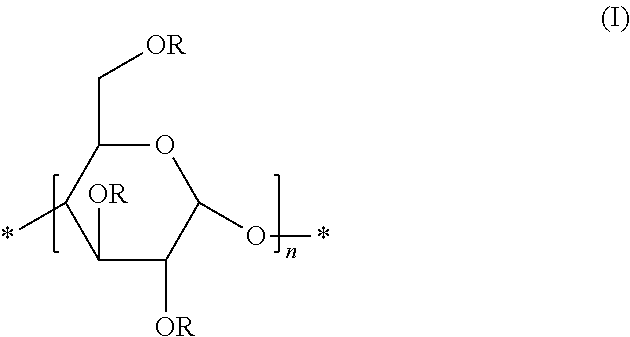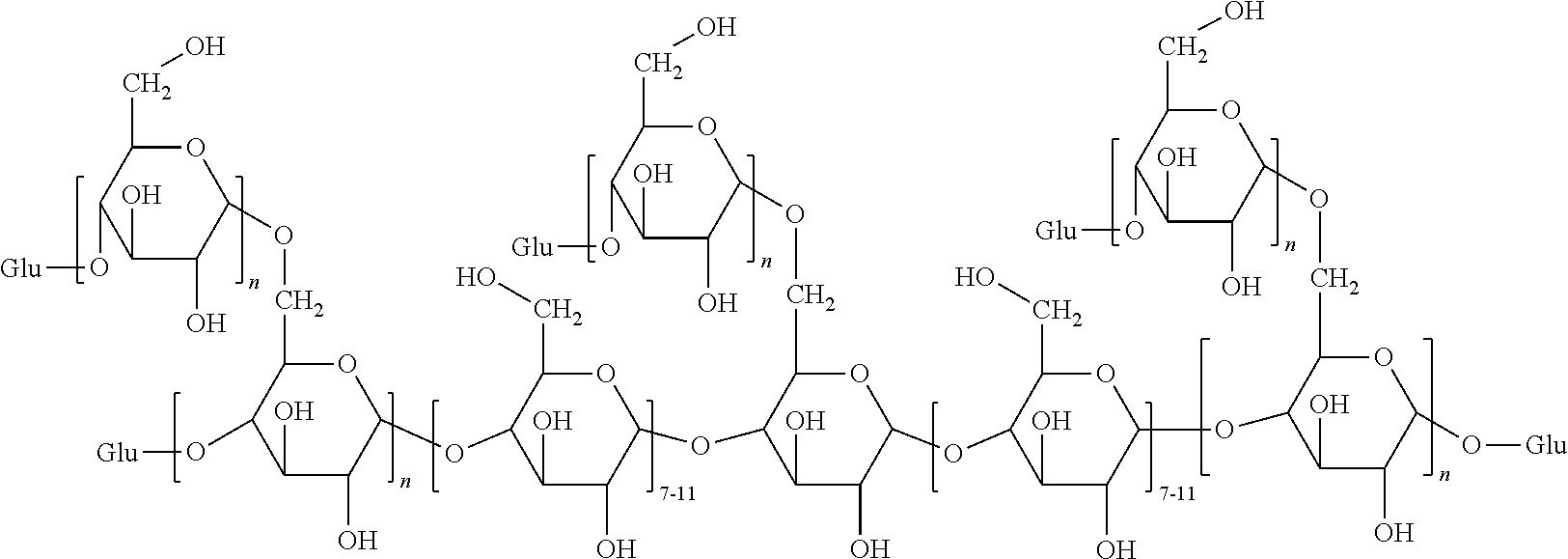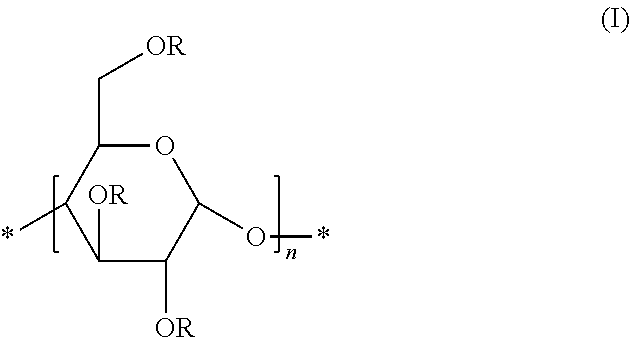Glycogen-based water solubility enhancers
- Summary
- Abstract
- Description
- Claims
- Application Information
AI Technical Summary
Benefits of technology
Problems solved by technology
Method used
Image
Examples
example 1
Preparation of Glycogen-Based Polymers Comprising the Unit (I)
[0103]Polglumyt® glycogen (5 g; 30.86 mmol of glucose) was dried under vacuum at 60° C. for several days to remove the physically adsorbed water. After cooling to room temperature, under nitrogen atmosphere, the polymer was dissolved in dry dimethylsulfoxide (100 mL) in a two-necked round-bottomed flask, equipped with a magnetic stirrer and a reflux condenser.
[0104]Sodium hydride (NaH) was then added and the mixture was stirred at room temperature for 1 hour. Then, the reagent (R—X) was added, and the mixture was stirred at room temperature overnight. The amounts of sodium hydride and reagents R—X, expressed as mmol, are reported in Table 1.
[0105]The next day, 300 mL of ethanol were added and the mixture was centrifuged. The precipitate was recovered and washed twice with 100 ml of ethanol, centrifuged and the solid product was recovered. The solid obtained was dissolved in water (150 mL) and finally subjected to dialysis...
example 2
Evaluation of Solubility Enhancement
[0111]Twelve water solutions containing 5 mg / mL of each compound synthesized in example 1 were prepared. The suspensions were left under stirring for 24 hours. Solutions A to N were obtained.
[0112]Similarly, four water solutions containing 5 mg / mL of the compound of the following table 4 were prepared. The suspensions were left under stirring for 24 hours. Solutions O to R were obtained.
TABLE 4CompoundName13natural glycogen (Polglumyt ®)14γ-cyclodextrin (CAVAMAX W8)15β-cyclodextrin (CAVAMAX W7)16HP-β-cyclodextrin (CAVASOL W7 HP)
[0113]An excess amount of β-carotene (5 mg / mL) was added to 1 mL of each solution A to R. The suspension was mixed using a laboratory shaker at room temperature for 24 hours. The concentration (mg / mL) of solubilized β-carotene was determined by HPLC analysis. The sample was prepared for chromatographic analysis by filtering through a 0.45 μm MCE filter.
[0114]The chromatographic system (Waters) consisted of a solvent deliver...
example 3
Evaluation of Solubility Enhancement
[0123]An excess amount of astaxanthin (1 mg / mL) was added to 1 mL of each solution A to R, prepared as for example 2. The suspension was mixed using a laboratory shaker at room temperature for 24 hours. The concentration (mg / mL) of solubilized astaxanthin was determined by HPLC analysis. The sample was prepared for chromatographic analysis by filtering through a 0.45 μm MCE filter.
[0124]The chromatographic system (Waters) consisted of a solvent delivery module (Model Alliance e2695), a variable-wavelength UV spectrophotometric detector (Model 2489) and a chromatographic data control and acquisition system (Empower). An X-Bridge™ Shield RP18 column (4.6×150 mm) was used. A suitable HPLC analytical method was developed for quantitating the amount of astaxanthin in solution.
[0125]Elution was performed by gradient elution using a mixture of acetonitrile / tetrahydrofuran at a weight ratio of 70:30 in channel A and water in channel B. The flow rate was 1...
PUM
| Property | Measurement | Unit |
|---|---|---|
| Mass | aaaaa | aaaaa |
| Mass | aaaaa | aaaaa |
| Solubility (mass) | aaaaa | aaaaa |
Abstract
Description
Claims
Application Information
 Login to View More
Login to View More - R&D
- Intellectual Property
- Life Sciences
- Materials
- Tech Scout
- Unparalleled Data Quality
- Higher Quality Content
- 60% Fewer Hallucinations
Browse by: Latest US Patents, China's latest patents, Technical Efficacy Thesaurus, Application Domain, Technology Topic, Popular Technical Reports.
© 2025 PatSnap. All rights reserved.Legal|Privacy policy|Modern Slavery Act Transparency Statement|Sitemap|About US| Contact US: help@patsnap.com



